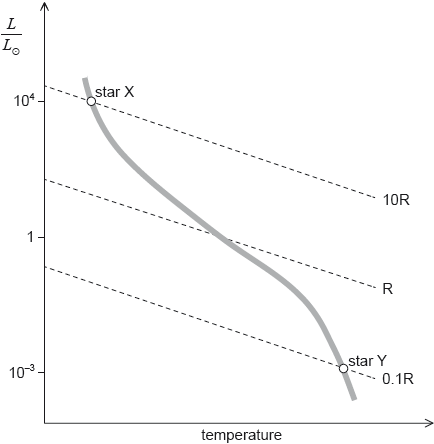| Date | November 2019 | Marks available | 1 | Reference code | 19N.3.SL.TZ0.10 |
| Level | Standard level | Paper | Paper 3 | Time zone | 0 - no time zone |
| Command term | Draw | Question number | 10 | Adapted from | N/A |
Question
Eta Cassiopeiae A and B is a binary star system located in the constellation Cassiopeia.
The following data are available.
Apparent brightness of Eta Cassiopeiae A = 1.1 × 10–9 Wm–2
Apparent brightness of Eta Cassiopeiae B = 5.4 × 10–11 Wm–2
Luminosity of the Sun, = 3.8 × 1026 W
A Hertzsprung–Russell (HR) diagram is shown.
Distinguish between a constellation and a stellar cluster.
The peak wavelength of radiation from Eta Cassiopeiae A is 490 nm. Show that the surface temperature of Eta Cassiopeiae A is about 6000 K.
The surface temperature of Eta Cassiopeiae B is 4100 K. Determine the ratio .
The distance of the Eta Cassiopeiae system from the Earth is 1.8 × 1017 m. Calculate, in terms of , the luminosity of Eta Cassiopeiae A.
On the HR diagram, draw the present position of Eta Cassiopeiae A.
State the star type of Eta Cassiopeiae A.
Calculate the ratio .
Deduce the final evolutionary state of Eta Cassiopeiae A.
Markscheme
stars in a cluster are gravitationally bound OR in constellation are not ✔
stars in a cluster are the same/similar age OR in constellation are not ✔
stars in a cluster are close in space/the same distance away OR in constellation are not ✔
stars in a cluster originate from same gas cloud OR in constellation do not ✔
stars in a cluster appear much closer in night sky than in a constellation ✔
Notes: Take care to reward only 1 comment from a given marking point for MP1 to MP5.
«»
5900 K ✔
NOTE: Answer 6000 K is given in the question.
Answer must be to at least 2 s.f. OR correct working.
«from b∝ L∝ R2 T4»
realization that «for binary stars which are same distance away» ✔
✔
✔
NOTE: Award [2] for answer 0.46 from inverted ratio.
«use of »
✔
✔
approximately correct position on the main sequence as shown, within highlighted region ✔
main sequence star
OR
type F or G star ✔
✔
mass of the «remnant» star OR Chandrasekhar limit
OR
mass OR luminosity similar to the Sun ✔
the final stage is white dwarf ✔


